Journal Description
Fibers
Fibers
is an international, peer-reviewed, open access journal on fiber science, published monthly online by MDPI.
- Open Access— free for readers, with article processing charges (APC) paid by authors or their institutions.
- High Visibility: indexed within Scopus, ESCI (Web of Science), Ei Compendex, PubAg, CAPlus / SciFinder, Inspec, and other databases.
- Journal Rank: JCR - Q2 (Materials Science, Multidisciplinary) / CiteScore - Q1 (Civil and Structural Engineering)
- Rapid Publication: manuscripts are peer-reviewed and a first decision is provided to authors approximately 23.3 days after submission; acceptance to publication is undertaken in 5.8 days (median values for papers published in this journal in the first half of 2025).
- Recognition of Reviewers: reviewers who provide timely, thorough peer-review reports receive vouchers entitling them to a discount on the APC of their next publication in any MDPI journal, in appreciation of the work done.
Impact Factor:
3.9 (2024);
5-Year Impact Factor:
4.1 (2024)
Latest Articles
Synthesis and Characterization of Keratin-Based Scaffold for Potential Tissue Engineering Applications
Fibers 2025, 13(7), 97; https://doi.org/10.3390/fib13070097 - 17 Jul 2025
Abstract
►
Show Figures
Keratin, a fibrous structural protein, has been employed as a biomaterial for hemostasis and tissue repair due to its structural stability, mechanical strength, biocompatibility, and biodegradability. While extensive research has focused on developing scaffolds using keratin extracted from various sources, no studies to
[...] Read more.
Keratin, a fibrous structural protein, has been employed as a biomaterial for hemostasis and tissue repair due to its structural stability, mechanical strength, biocompatibility, and biodegradability. While extensive research has focused on developing scaffolds using keratin extracted from various sources, no studies to date have explored the use of keratin derived from human nail clippings. In this study, keratin was extracted from human nail clippings using the Shindai method and used to fabricate and compare two types of scaffolds for bone tissue engineering via the freeze-drying method. The first scaffold consisted of keratin combined with gelatin (KG), while the second combined keratin, gelatin, and hydroxyapatite (HAp) (KGH), the latter synthesized from blood cockle clam shells using the wet precipitation method. Physicochemical characterization and surface morphology analysis of keratin and both scaffolds showed promising results. Tensile strength testing revealed a significant difference in Young’s modulus. The KG scaffold exhibited higher porosity, water uptake, and water retention capacity compared to the KGH scaffold. In vitro biocompatibility studies revealed that the KGH scaffold supported higher cell proliferation compared to the KG scaffold. This study demonstrates the potential of using human nail-derived keratin in composite scaffold fabrication and serves as a foundation for future research on this novel biomaterial source.
Full article
Open AccessArticle
The Effects of Polypropylene Fibres on the Shear Behaviour of a Concrete Crack: An Experimental Study
by
Francisco Ortiz-Navas, Juan Navarro-Gregori and Pedro Serna
Fibers 2025, 13(7), 96; https://doi.org/10.3390/fib13070096 - 11 Jul 2025
Abstract
The objective of this study is to investigate the effects of macrosynthetic polypropylene fibres as shear reinforcement in a concrete crack. An experimental study was conducted using twenty push-off specimens with varying volumes of fibres, along with plain concrete specimens as a reference.
[...] Read more.
The objective of this study is to investigate the effects of macrosynthetic polypropylene fibres as shear reinforcement in a concrete crack. An experimental study was conducted using twenty push-off specimens with varying volumes of fibres, along with plain concrete specimens as a reference. The testing methodology allowed for the analysis of crack kinematics by measuring the evolution of normal and shear stresses in relation to slip and crack opening. This facilitated the creation of diagrams similar to those presented by Walraven (1980) for crack interface shear transfer, but in this case, applied to concrete reinforced with macrosynthetic polypropylene fibres. The findings demonstrate that macrosynthetic polypropylene fibres significantly enhance shear behaviour, particularly when their volume exceeds 8 kg/m3. This study provides valuable insights into the behaviour of macrosynthetic polypropylene fibres under shear loading conditions and highlights their potential benefits as effective shear reinforcement.
Full article
(This article belongs to the Special Issue Fracture Behavior of Fiber-Reinforced Building Materials)
►▼
Show Figures

Figure 1
Open AccessArticle
Quality of Plywood Bonded with Nanolignin-Enriched Cardanol-Formaldehyde Adhesive
by
Maria Rita Ramos Magalhães, Felipe Gomes Batista, Ana Carolina Corrêa Furtini, Mário Vanoli Scatolino, Flávia Maria Silva Brito, Lourival Marin Mendes, Thiago de Paula Protásio and José Benedito Guimarães Junior
Fibers 2025, 13(7), 95; https://doi.org/10.3390/fib13070095 - 10 Jul 2025
Abstract
►▼
Show Figures
Cardanol is a derivative of cashew nut shell liquid (CNSL) and has the potential to be used when developing adhesives for wood boards. Adding nanostructures to adhesive can increase its bonding and reduce formaldehyde emission. Therefore, this study aimed to evaluate the different
[...] Read more.
Cardanol is a derivative of cashew nut shell liquid (CNSL) and has the potential to be used when developing adhesives for wood boards. Adding nanostructures to adhesive can increase its bonding and reduce formaldehyde emission. Therefore, this study aimed to evaluate the different concentrations of nanolignin (1, 2, and 3%) added to the cardanol-formaldehyde adhesive for gluing plywood, in comparison to the cardanol-formaldehyde adhesive without nanolignin (0%). The plywood’s physical, mechanical, and formaldehyde emission properties were assessed. Plywoods with nanolignin showed shear strength increases of around 160% in the wet condition. With the addition of nanolignin, the modulus of rupture and of elasticity increased by approximately 150% and up to 400% in the parallel direction, respectively. The resistance to combustion also significantly improved. Physical properties did not show statistically significant differences with the percentages of nanolignin. Despite the increase in formaldehyde emission with nanolignin, all treatments met the marketing requirements (≤80 mg of formaldehyde/kg), demonstrating the adhesive potential for indoor use in plywood industries. Natural adhesives using cardanol and nanolignin are an innovative and ecological alternative, combining sustainability and high potential to reduce environmental impacts, which is aligned with at least four sustainable development goals (SDGs).
Full article

Figure 1
Open AccessArticle
Electrospun Silk Fibroin/Cyclodextrin Nanofibers for Multifunctional Air Filtration
by
Papimol Mongyun and Sompit Wanwong
Fibers 2025, 13(7), 94; https://doi.org/10.3390/fib13070094 - 8 Jul 2025
Abstract
►▼
Show Figures
Particulate matter (PM) and volatile organic compounds (VOCs) are major air pollutants that can cause significant risks to public health. To mitigate exposure, fibrous filters have been widely utilized for air purification. In this study, we developed electrospun silk fibroin/poly (ethylene oxide)/cyclodextrin (SF/PEO/CD)
[...] Read more.
Particulate matter (PM) and volatile organic compounds (VOCs) are major air pollutants that can cause significant risks to public health. To mitigate exposure, fibrous filters have been widely utilized for air purification. In this study, we developed electrospun silk fibroin/poly (ethylene oxide)/cyclodextrin (SF/PEO/CD) nanofibers as multifunctional air filters capable of efficiently reducing PM2.5 and degrading VOCs. The resulting SF/PEO/10CD demonstrated the best multifunctional filtration performance, achieving PM2.5 capture efficiencies of 91.3% with a minimal pressure drop of 4 Pa and VOC removal efficiency of 50%. These characteristics highlight the potential of the SF/PEO/10CD nanofiber with effective, multifunctional properties and environmental benefits for sustainable air filtration application.
Full article
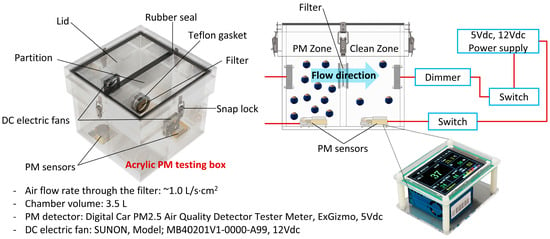
Figure 1
Open AccessArticle
Performance of Hybrid Strengthening System for Reinforced Concrete Member Using CFRP Composites Inside and over Transverse Groove Technique
by
Ahmed H. Al-Abdwais and Adil K. Al-Tamimi
Fibers 2025, 13(7), 93; https://doi.org/10.3390/fib13070093 - 8 Jul 2025
Abstract
►▼
Show Figures
The use of a carbon-fiber-reinforced polymer (CFRP) for structural strengthening has been widely adopted in recent decades. Early studies focused on externally bonded (EB) techniques, but premature delamination of CFRP from concrete surfaces often limited their efficiency. To address this, alternative methods, such
[...] Read more.
The use of a carbon-fiber-reinforced polymer (CFRP) for structural strengthening has been widely adopted in recent decades. Early studies focused on externally bonded (EB) techniques, but premature delamination of CFRP from concrete surfaces often limited their efficiency. To address this, alternative methods, such as Externally Bonded Reinforcement Over Grooves (EBROG) and Externally Bonded Reinforcement Inside Grooves (EBRIG), were developed to enhance the bond strength and delay delamination. While most research has examined longitudinal groove layouts, this study investigates a hybrid system combining a CFRP fabric bonded inside transverse grooves (EBRITG) with externally bonded layers over the grooves (EBROTG). The system leverages the grooves’ surface area to anchor the CFRP and improve the bonding strength. Seven RC beams were tested in two stages: five beams with varied strengthening methods (EBROG, EBRIG, and hybrid) in the first stage and two beams with a hybrid system and concrete cover anchorage in the second stage. Results demonstrated significant flexural capacity improvement—57% and 72.5% increase with two and three CFRP layers, respectively—compared to the EBROG method, confirming the hybrid system’s superior bonding efficiency.
Full article

Figure 1
Open AccessArticle
Kapok-Derived Super Hollow Porous Carbon Fibers and Their Greenhouse Gases Adsorption
by
Hun-Seung Jeong, Cheol-Ki Cho, Dong-Chul Chung, Kay-Hyeok An and Byung-Joo Kim
Fibers 2025, 13(7), 92; https://doi.org/10.3390/fib13070092 - 4 Jul 2025
Abstract
►▼
Show Figures
Industrialization and modernization have significantly improved the quality of life but have also led to substantial pollution. Cost-effective technologies are urgently needed to mitigate emissions from major polluting sectors, such as the automotive and transport industries. In this study, we synthesized naturally derived,
[...] Read more.
Industrialization and modernization have significantly improved the quality of life but have also led to substantial pollution. Cost-effective technologies are urgently needed to mitigate emissions from major polluting sectors, such as the automotive and transport industries. In this study, we synthesized naturally derived, kapok-based porous carbon fibers (KP-PCFs) with hollow structures. We investigated their adsorption/desorption behavior for the greenhouse gas n-butane following ASTM D5228 standards. Scanning electron microscopy and X-ray diffraction analyses were conducted to examine changes in fiber diameter and crystalline structure under different activation times. The micropore properties of KP-PCFs were characterized using Brunauer–Emmett–Teller, t-plot, and non-localized density functional theory models based on N2/77K adsorption isotherm data. The specific surface area and total pore volume ranged from 500 to 1100 m2/g and 0.24 to 0.60 cm3/g, respectively, while the micropore and mesopore volumes were 0.20–0.45 cm3/g and 0.04–0.15 cm3/g, respectively. With increasing activation time, the n-butane adsorption capacity improved from 62.2% to 73.5%, whereas retentivity (residual adsorbate) decreased from 6.0% to 1.3%. The adsorption/desorption rate was highly correlated with pore diameter: adsorption capacity was highest for diameters of 1.5–2.5 nm, while retentivity was greatest for diameters of 3.5–5.0 nm.
Full article
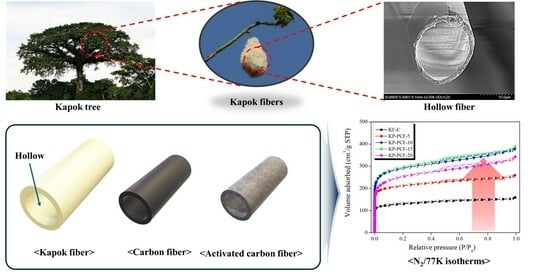
Graphical abstract
Open AccessArticle
Developing JMP and VBA Add-Ins for Finite Mixture Modeling of Cotton Fiber Length Distribution
by
Mourad Krifa, Vinusha Garlapati, Vikki B. Martin and Neha Kothari
Fibers 2025, 13(7), 91; https://doi.org/10.3390/fib13070091 - 2 Jul 2025
Abstract
►▼
Show Figures
In this study, software add-ins were developed and presented to allow data processing and statistical analysis of the unique shape of cotton fiber length distribution. The approach uses VBA coding in Excel to process the data, as well as the JMP 14-17 application
[...] Read more.
In this study, software add-ins were developed and presented to allow data processing and statistical analysis of the unique shape of cotton fiber length distribution. The approach uses VBA coding in Excel to process the data, as well as the JMP 14-17 application and add-in builder tools to fit finite mixture models to empirical fiber length distributions. The resulting model derives a parametric expression for the fiber length probability density function. The analysis add-in was applied and validated on a wide range of empirical length distributions and proved to parameterize the complex distribution patterns with an excellent goodness of fit. Both tools were compiled into installable add-ins that extended the capabilities of MS Excel for the processing of AFIS distribution reports and the statistical toolbox of JMP using the Application Builder JSL coding. Installable add-ins, along with a user manual, are available for download by cotton researchers.
Full article

Figure 1
Open AccessArticle
Recycling Particleboard by Acid Hydrolysis: Effects on the Physical, Thermal, and Chemical Characteristics of Recycled Wood Particles
by
Gustavo E. Rodríguez, Rosilei Garcia and Alain Cloutier
Fibers 2025, 13(7), 90; https://doi.org/10.3390/fib13070090 - 2 Jul 2025
Abstract
►▼
Show Figures
Acid hydrolysis can be more efficient than water hydrolysis, particularly in breaking down cured adhesives found in waste panels within a shorter reaction time, which could benefit large-scale industrial processes. This study evaluates the effects of various acid hydrolysis conditions on the thermal,
[...] Read more.
Acid hydrolysis can be more efficient than water hydrolysis, particularly in breaking down cured adhesives found in waste panels within a shorter reaction time, which could benefit large-scale industrial processes. This study evaluates the effects of various acid hydrolysis conditions on the thermal, physical, and chemical properties of recycled particles intended for particleboard production. Particleboards were recycled using oxalic acid and ammonium chloride at different concentrations and reaction times at 122 °C. The thermal stability of the particles was determined by thermogravimetric analysis. Particle size distribution, particle morphology, nitrogen content, pH and acid/base buffer capacity were analyzed. The effect of the recycled particles on the urea-formaldehyde (UF) curing was assessed using differential scanning calorimetry and the gel time method. The recycled particles exhibited a higher thermal degradation beyond 200 °C, indicating their thermal stability for manufacturing new panels. The acid treatments did not damage the anatomical structure of the particles, preserving the prosenchymatous elements. The nitrogen content of recycled particles decreased by up to 90% when oxalic acid was used, compared to raw board particles. Recycled particles exhibited a lower pH, with a maximum reduction of 44%. They also showed a decreased acid buffer capacity and an increased base buffer capacity compared to raw board particles. This effect was particularly pronounced in treatments that included ammonium chloride. The recycled particles did not significantly affect the peak polymerization temperature of the UF adhesive. However, some treatments affected the gel time of the adhesive, particularly those using 30% ammonium chloride. The results indicate that particleboards can be effectively recycled through acid hydrolysis, mainly with oxalic acid, which provides better results than hydrolysis using water alone. Oxalic acid showed increased selectivity in eliminating the cured UF adhesive, resulting in recycled particles suitable for manufacturing new panels.
Full article
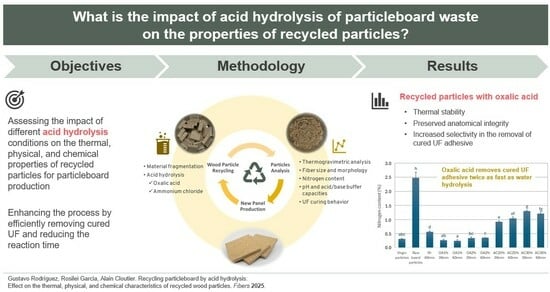
Graphical abstract
Open AccessArticle
Influence of Encapsulation Size and Textile Integration Techniques on the Wash Durability of Textiles with Integrated Electronic Yarn
by
Arash M. Shahidi, Parvin Ebrahimi, Kalana Marasinghe, Tharushi Peiris, Zahra Rahemtulla, Carlos Oliveira, Dominic Eberl-Craske, Tilak Dias and Theo Hughes-Riley
Fibers 2025, 13(7), 89; https://doi.org/10.3390/fib13070089 - 2 Jul 2025
Abstract
►▼
Show Figures
A crucial factor when developing e-textiles is ensuring their robustness and functionality during everyday activities, particularly washing. The ability to launder e-textile garments is not merely a matter of convenience but a necessity for widespread adoption. Incorporating electronics into textiles can lead to
[...] Read more.
A crucial factor when developing e-textiles is ensuring their robustness and functionality during everyday activities, particularly washing. The ability to launder e-textile garments is not merely a matter of convenience but a necessity for widespread adoption. Incorporating electronics into textiles can lead to damage due to mechanical and chemical stresses, which most electronics are not designed to withstand. This work focuses on electronic yarn technology (e-yarn), in which electronic functionality is added to textiles by embedding small electronic components into a flexible yarn-like structure. First, the component is soldered onto thin conductive wires. The soldered component is then enclosed in a protective polymer resin (micro-pod). Micro-pods have different diameters depending on the size of the embedded electronic component. The ensemble is finally covered in a textile sheath. This study focuses on the wash durability of e-yarns integrated with textiles in three different ways: embroidered onto the surface of a woven fabric, within a knitted channel in a knitted fabric, and woven as a weft yarn. Further, the work studied the impact of using different sizes of micro-pods on the e-yarns’ wash durability. Ultimately, good wash durability was observed under all testing conditions.
Full article
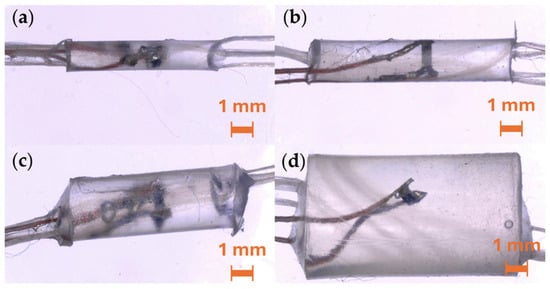
Figure 1
Open AccessArticle
Embedding 1D Euler Beam in 2D Classical Continua
by
Armine Ulukhanyan, Luca Placidi, Anil Misra, Roberto Fedele, Raimondo Luciano and Francesco Fabbrocino
Fibers 2025, 13(7), 88; https://doi.org/10.3390/fib13070088 - 1 Jul 2025
Abstract
►▼
Show Figures
In this contribution, the classical Cauchy first-gradient elastic theory is used to solve the equilibrium problem of a bidimensional (2D) reinforced elastic structure under small displacements and strains. Such a 2D first-gradient continuum is embedded with a reinforcement, which is modeled as a
[...] Read more.
In this contribution, the classical Cauchy first-gradient elastic theory is used to solve the equilibrium problem of a bidimensional (2D) reinforced elastic structure under small displacements and strains. Such a 2D first-gradient continuum is embedded with a reinforcement, which is modeled as a zero-thickness interface endowed with the elastic properties of an extensional Euler–Bernoulli 1D beam. Modeling the reinforcement as an interface eliminates the need for a full geometric representation of the reinforcing bar with finite thickness in the 2D model, and the associated mesh discretization for numerical analysis. Thus, the effects of the 1D beam-like reinforcements are described through proper and generalized boundary conditions prescribed to contiguous continuum regions, deduced from a standard variational approach. The novelty of this work lies in the formulation of an interface model coupling 1D and 2D continua, based on weak formulation and variational derivation, capable of accurately capturing stress distributions without requiring full geometric resolution of the reinforcement. The proposed framework is therefore illustrated by computing, with finite element simulations, the response of the reinforced structural element under uniform bending. Numerical results reveal the presence of jumps for some stress components in the vicinity of the reinforcement tips and demonstrate convergence under mesh refinement. Although the reinforcement beams possess only axial stiffness, they significantly influence the equilibrium configuration by causing a redistribution of stress and enhancing stress transfer throughout the structure. These findings offer a new perspective on the effective modeling of fiber-reinforced structures, which are of significant interest in engineering applications such as micropiles in foundations, fiber-reinforced concrete, and advanced composite materials. In these systems, stress localization and stability play a critical role.
Full article
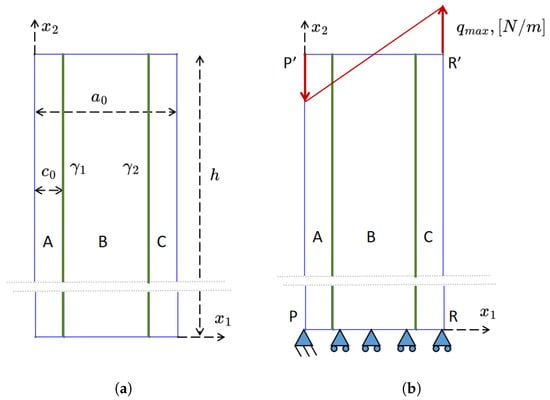
Figure 1
Open AccessArticle
Physical and Mechanical Characterization of Flax Fibers: From Elementary Fiber to Yarn
by
Wafa Mahjoub and Omar Harzallah
Fibers 2025, 13(7), 87; https://doi.org/10.3390/fib13070087 - 30 Jun 2025
Abstract
►▼
Show Figures
This study presents a multiscale characterization of flax fibers, from elementary fibers to technical bundles and yarns, to elucidate how fiber scale attributes influence yarn mechanics. Four yarn counts (111.11 tex, 100 tex, 90.9 tex, and 83.33 tex) were produced via dry spinning,
[...] Read more.
This study presents a multiscale characterization of flax fibers, from elementary fibers to technical bundles and yarns, to elucidate how fiber scale attributes influence yarn mechanics. Four yarn counts (111.11 tex, 100 tex, 90.9 tex, and 83.33 tex) were produced via dry spinning, and tensile testing performed at each structural level. The results revealed a progressive decline in a specific modulus from elementary fibers (1.09 ± 0.62 N/tex) to short bundles (14.41 ± 9.59 N/tex), primarily due to fiber misalignment. Post hoc analysis confirmed that finer yarns (83.33 tex) exhibited higher stiffness (7.32 ± 1.69 N/tex, p < 0.001), attributed to advanced processing (GN4 combing). These findings highlight the critical role of fiber length and alignment in optimizing flax yarns for high-performance textiles.
Full article
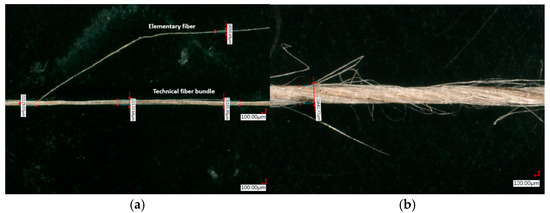
Figure 1
Open AccessArticle
Structure and Crystallization of Even–Odd Nylons Derived from Pimelic Acid: Influence of the Number of Methylene Groups in the Diamine Unit
by
Matteo Arioli, Lourdes Franco and Jordi Puiggalí
Fibers 2025, 13(7), 86; https://doi.org/10.3390/fib13070086 - 27 Jun 2025
Abstract
►▼
Show Figures
Nylons 6,7, 8,7 and 10,7 have been synthesized by interfacial polycondensation and characterized. Thermal properties and thermally induced structural transitions have been evaluated to complement the reported data on nylon 4,7. Therefore, the complete even–odd series derived from pimelic acid is here fully
[...] Read more.
Nylons 6,7, 8,7 and 10,7 have been synthesized by interfacial polycondensation and characterized. Thermal properties and thermally induced structural transitions have been evaluated to complement the reported data on nylon 4,7. Therefore, the complete even–odd series derived from pimelic acid is here fully characterized, in order to insist on their peculiar structural polymorphism. Real-time WAXD synchrotron experiments were conducted during heating, cooling and reheating processes. Basically, three structures were involved: a modified α-form, a distorted pseudohexagonal form and a pseudohexagonal form. The modified α-form was stable up to relatively low temperatures (i.e., lower than 140 °C), was mainly produced by solution crystallization and was progressively disfavored when the number of methylene groups of the diamine moiety increased. A progressive transition from the modified α-form to the distorted pseudohexagonal structure was observed during heating. Also, a continuous reverse transition was detected on cooling, although the yield on the modified α-form was low. A Brill transition towards a pseudohexagonal structure was observed in all cases. This transition was reversible, although with some hysteresis degree. Oriented fiber patterns corresponding to the distorted pseudohexagonal structure were obtained by melt stretching. In all cases, the 00l reflections appeared with a meridional orientation and indicated a shortening close to 0.05 nm/amide group with respect to the expected values for fully extended conformations.
Full article
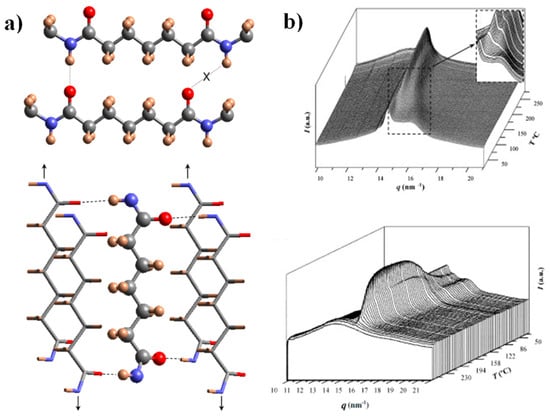
Figure 1
Open AccessArticle
The Effect of a Carbon Fiber Layer Between the Cathode and the Current Collector on Battery Cell Performance
by
Jaswinder Sharma, Runming Tao, Georgios Polizos, Ruhul Amin, Yue Feng, Junbin Choi, M. Shahriar and Jianlin Li
Fibers 2025, 13(7), 85; https://doi.org/10.3390/fib13070085 - 27 Jun 2025
Abstract
►▼
Show Figures
Contact resistance between the cathode active material (CAM) and the Al current collector can be reduced by applying carbon coatings to the Al current collector surface. However, this process requires an additional step of carbon layer coating on the current collector, which increases
[...] Read more.
Contact resistance between the cathode active material (CAM) and the Al current collector can be reduced by applying carbon coatings to the Al current collector surface. However, this process requires an additional step of carbon layer coating on the current collector, which increases both manufacturing costs and processing time. In the present work, an interlayer of continuous unsized carbon fibers aligned in one direction (CF interlayer), is introduced between the Al current collector and the NMC811 cathode during cathode deposition on the Al current collector. This single-step approach eliminates the need for the additional carbon layer coating on the current collector. Additionally, this approach removes the use of toxic solvents and insulative polymers used for making the carbon coating. The CF interlayer improves the rate capability at higher C-rates. The CF interlayer lowers the contact resistance between the cathode particles and the current collector while improving the activation energy of charge transfer. The peel test showed that the CF interlayer does not affect the adhesion strength of the cathode layer with the current collector.
Full article

Graphical abstract
Open AccessArticle
Constitutive Model for Plain and Steel-Fibre-Reinforced Lightweight Aggregate Concrete Under Direct Tension and Pull-Out
by
Hasanain K. Al-Naimi and Ali A. Abbas
Fibers 2025, 13(7), 84; https://doi.org/10.3390/fib13070084 - 23 Jun 2025
Abstract
►▼
Show Figures
In the present study, a programme of experimental investigations was carried out to examine the direct uniaxial tensile (and pull-out) behaviour of plain and fibre-reinforced lightweight aggregate concrete. The lightweight aggregates were recycled from fly ash waste, also known as Pulverised Fuel Ash
[...] Read more.
In the present study, a programme of experimental investigations was carried out to examine the direct uniaxial tensile (and pull-out) behaviour of plain and fibre-reinforced lightweight aggregate concrete. The lightweight aggregates were recycled from fly ash waste, also known as Pulverised Fuel Ash (PFA), which is a by-product of coal-fired electricity power stations. Steel fibres were used with different aspect ratios and hooked ends with single, double and triple bends corresponding to 3D, 4D and 5D types of DRAMIX steel fibres, respectively. Key parameters such as the concrete compressive strength flck, fibre volume fraction Vf, number of bends nb, embedded length LE and inclination angle ϴf were considered. The fibres were added at volume fractions Vf of 1% and 2% to cover the practical range, and a direct tensile test was carried out using a purpose-built pull-out test developed as part of the present study. Thus, the tensile mechanical properties were established, and a generic constitutive tensile stress–crack width σ-ω model for both plain and fibrous lightweight concrete was created and validated against experimental data from the present study and from previous research found in the literature (including RILEM uniaxial tests) involving different types of lightweight aggregates, concrete strengths and steel fibres. It was concluded that the higher the number of bends nb and the higher the volume fraction Vf and concrete strength flck, the stronger the fibre–matrix interfacial bond and thus the more pronounced the enhancement provided by the fibres to the uniaxial tensile residual strength and ductility in the form of work and fracture energy. A fibre optimisation study was also carried out, and design recommendations are provided.
Full article
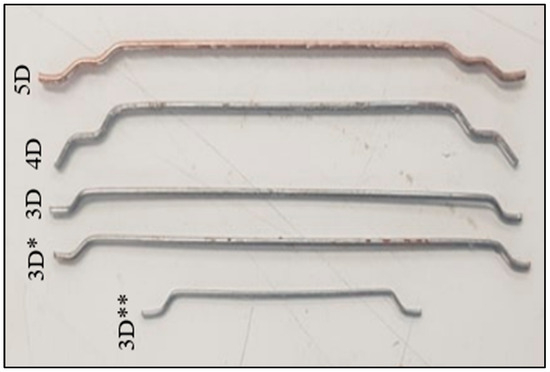
Figure 1
Open AccessReview
Converging Electrospinning and 3D-Printing Technologies: From Innovative Design for Tissue Engineering to Global Patent Trends and Technology Transfer
by
Karen J. Juarez-Navarro, Vincenzo Guarino and Marco A. Alvarez-Perez
Fibers 2025, 13(6), 83; https://doi.org/10.3390/fib13060083 - 19 Jun 2025
Abstract
►▼
Show Figures
Electrospinning is a technique that enables the production of nano- and microfibrillar patterns that mimic the native extracellular matrix. However, these nanofibrous structures often lack mechanical properties suitable for reproducing the behavior of structurally complex tissues. Therefore, achieving more accurate and precise geometric
[...] Read more.
Electrospinning is a technique that enables the production of nano- and microfibrillar patterns that mimic the native extracellular matrix. However, these nanofibrous structures often lack mechanical properties suitable for reproducing the behavior of structurally complex tissues. Therefore, achieving more accurate and precise geometric structures be-comes a key challenge. In this context, additive manufacturing techniques such as 3D printing may allow for the development of tailored structures with highly controlled ar-chitecture and improved mechanical strength. However, in contrast with electrospinning, these techniques are commonly considered “low-resolution” techniques, unable to ma-nipulate structural details at the submicrometric scale. Hence, this review aims to intro-duce and discuss recent technological approaches based on combining these technologies for scaffold development in tissue engineering, detailing some distinct integration strate-gies correlating the outcomes to the benefits and drawbacks. Finally, a comprehensive analysis of the current state of the art in the registered intellectual property related to these integrated approaches will be proposed, assessing their distribution by geographic region and analyzing the main trends over time and future fallouts.
Full article

Figure 1
Open AccessArticle
Optimization of Process of Dyeing Alpaca Yarn Using Indigo Carmine (C.I. Natural Blue 2)
by
Cristina M. Luque-Jacobo, Elizabeth Medrano de Jara, Jose Carrasco Bocangel and Edgar García-Hernández
Fibers 2025, 13(6), 82; https://doi.org/10.3390/fib13060082 - 18 Jun 2025
Abstract
►▼
Show Figures
As part of an implementation in the Peruvian textile industry, the use of different sources to obtain blue hues in alpaca fiber has taken on a prominent role. The present study investigated the optimization of the dyeing process of alpaca fibers using indigo
[...] Read more.
As part of an implementation in the Peruvian textile industry, the use of different sources to obtain blue hues in alpaca fiber has taken on a prominent role. The present study investigated the optimization of the dyeing process of alpaca fibers using indigo carmine as dye. The methodology was based on a central composite design (CCD) and response surface methodology (RSM) with color strength (K/S) as response variable. The results demonstrate that the independent variables significantly affected the color strength (K/S). In this context, an increase in both mordant concentration (3.9887 g/L) and dyeing temperature (95 °C), coupled with lower exhaust time (30.0019 min), enhanced levels of superficial dye adsorption. Additionally, color fastness properties provided tolerable values according to the gray scale. In conclusion, the optimization of the dyeing process of alpaca fibers using indigo carmine enabled the achievement of a blue shade with satisfactory fastness properties in the fiber yarns.
Full article

Figure 1
Open AccessArticle
Harnessing the Unique Nature of Evanescent Waves: Optimizing FOEW LSPR Sensors with Absorption-Focused Nanoparticle Design
by
Omar Awad, AbdulRahman Ghannoum and Patricia Nieva
Fibers 2025, 13(6), 81; https://doi.org/10.3390/fib13060081 - 17 Jun 2025
Abstract
►▼
Show Figures
This work presents a novel and comprehensive framework for optimizing fiber optic evanescent wave (FOEW) localized surface plasmon resonance (LSPR) sensors by investigating the unique interaction between evanescent waves and plasmonic nanoparticles. Unlike propagating light, the evanescent wave is a localized, non-propagating field
[...] Read more.
This work presents a novel and comprehensive framework for optimizing fiber optic evanescent wave (FOEW) localized surface plasmon resonance (LSPR) sensors by investigating the unique interaction between evanescent waves and plasmonic nanoparticles. Unlike propagating light, the evanescent wave is a localized, non-propagating field that interacts exclusively with absorbing media near the fiber surface. This characteristic highlights the importance of prioritizing nanoparticle absorption over total extinction in FOEW sensor design. The optical response of silver nanoparticles was modeled across a size range of 10–100 nm, showing that absorption increases with particle number. Among the sizes tested, 30 nm silver nanoparticles exhibited the highest absorption efficiency, which was confirmed experimentally. An analytical adsorption kinetics model based on diffusion transport further predicted that smaller nanoparticles yield higher surface coverage, a result validated through atomic force microscopy (AFM) and scanning electron microscopy (SEM) imaging. Refractive index (RI) sensitivity tests conducted on sensors fabricated with 10 nm, 20 nm, and 30 nm silver nanoparticles revealed that while smaller nanoparticles produced higher initial absorption due to greater surface density, the 30 nm particles ultimately provided superior RI sensitivity due to their enhanced absorption efficiency. These findings underscore the significance of absorption-centered nanoparticle design in maximizing FOEW LSPR sensor performance.
Full article

Figure 1
Open AccessArticle
Experimental Investigation of the Behaviour of Short-Span FRP-Reinforced Glulam Beams with Hoops and Tension Anchoring
by
Herry Chen, Yannick Vetter, Catherine Shrimpton and Daniel Lacroix
Fibers 2025, 13(6), 80; https://doi.org/10.3390/fib13060080 - 17 Jun 2025
Abstract
►▼
Show Figures
Past research has shown that for short-span glulam beams reinforced with a simple tension GFRP fabric can lead to undesirable failure modes at the reinforcement termination point. An experimental programme aimed at investigating alternative reinforcement schemes comprising hoops and tension anchoring as an
[...] Read more.
Past research has shown that for short-span glulam beams reinforced with a simple tension GFRP fabric can lead to undesirable failure modes at the reinforcement termination point. An experimental programme aimed at investigating alternative reinforcement schemes comprising hoops and tension anchoring as an alternative to fan-type anchorage and full-length confinement was undertaken. Sixteen GFRP-reinforced glulam beams were tested to failure under four-point bending. Overall, the hoops and tension anchoring prevented premature debonding and stress concentration failures observed in beams reinforced with simple tension reinforcement. Improvements in the stiffness and strength were generally observed for all configurations with the average failure strain being on average 1.16 times larger than the unreinforced specimens. While hoops prevented undesirable failure modes, it had limited improvements when using bidirectional fabrics for the hoops. Conversely, the configurations with tension anchoring using bidirectional fabrics only resulted in improved performance with some level of post-peak resistance compared to the unreinforced specimens and those reinforced with simple tension reinforcement. For short-span beams, or any FRP-reinforced glulam beams where flexure is not the dominant failure mode, more robust modelling techniques are required to properly capture the distribution of the reinforcement.
Full article

Figure 1
Open AccessArticle
Optimising Mechanical Performance of Additive Manufactured Composites for Biomedical Applications
by
Abdul Qadir, Amadi Gabriel Udu and Norman Osa-uwagboe
Fibers 2025, 13(6), 79; https://doi.org/10.3390/fib13060079 - 13 Jun 2025
Abstract
►▼
Show Figures
The mechanical properties of additive manufactured (AM) short-fibre reinforced polymer (SFRP) composites are significantly influenced by infill patterns, fibre orientation, and fibre-matrix interactions. While previous studies have explored the role of process parameters in optimising AM components, the impact of infill geometry on
[...] Read more.
The mechanical properties of additive manufactured (AM) short-fibre reinforced polymer (SFRP) composites are significantly influenced by infill patterns, fibre orientation, and fibre-matrix interactions. While previous studies have explored the role of process parameters in optimising AM components, the impact of infill geometry on anisotropy and mechanical performance remains underexplored, particularly in the context of machine learning (ML). This study develops an ML-driven framework to predict the tensile and flexural properties of AM SFRP composites with different infill patterns, including triangular, hexagonal, and rectangular. AM structures were fabricated and subjected to tensile and flexural tests, with the data used to train ML models, including LightGBM, XGBoost, and artificial neural networks (ANN). The results showed that the triangular infill pattern had the highest tensile strength and stiffness, the hexagonal infill had the lowest flexural properties, and the rectangular infill exhibited performance levels that fell between those of the triangular and hexagonal patterns. The ML models demonstrated high prediction accuracy, with R-squared values exceeding 0.95. XGBoost performed best for predicting tensile properties of hexagonal infill, while ANN excelled with triangular and rectangular configurations. This study demonstrates the potential of machine learning to enhance the mechanical performance of additively manufactured SFRP composites by capturing the complex interplay between infill geometry and fibre-matrix interactions. Thus, providing additional data for the design of high-performance materials in applications such as biomedical devices.
Full article

Figure 1
Open AccessArticle
Non-Destructive Condition and Damage Assessment of Historic Weighted Silk
by
Marta Anghelone, Caroline Dalhed and Tanja Kimmel
Fibers 2025, 13(6), 78; https://doi.org/10.3390/fib13060078 - 10 Jun 2025
Abstract
►▼
Show Figures
Silk weighting is a process used to compensate for the weight loss caused by degumming, achieved by adding agents such as metallic salts to enhance the hand feel and appearance of the fibers. With the development of tin weighting procedures (ca. 1870s), the
[...] Read more.
Silk weighting is a process used to compensate for the weight loss caused by degumming, achieved by adding agents such as metallic salts to enhance the hand feel and appearance of the fibers. With the development of tin weighting procedures (ca. 1870s), the production of weighted silk tremendously increased, as the fast decay of such fabrics was attributed to the process itself. The weighted silk was largely used for evening wear and high-fashion garments, many of which nowadays are stored in textile collections, and often characterized by poor conservation conditions. Within the present work, a multi-analytical and interdisciplinary non-destructive protocol was established for studying the finishing techniques, characterizing the materials as well as the state of preservation of historic tin-weighted silk. The protocol involves a visual and haptic approach typical of conservation professionals, as well as analytical investigations such as X-Ray Fluorescence analyses, 3D digital microscopy, Scanning Electron Microscopy with Energy Dispersive Spectroscopy, and Fourier-transform Infrared Spectroscopy (FTIR) in Attenuated Total Reflection. Elemental analyses are effective for studying the technology of production, while FTIR emerged as a powerful tool for assessing the condition, through the carbonyl and crystallinity indices.
Full article

Graphical abstract

Journal Menu
► ▼ Journal Menu-
- Fibers Home
- Aims & Scope
- Editorial Board
- Reviewer Board
- Topical Advisory Panel
- Instructions for Authors
- Special Issues
- Topics
- Topical Collections
- Article Processing Charge
- Indexing & Archiving
- Editor’s Choice Articles
- Most Cited & Viewed
- Journal Statistics
- Journal History
- Journal Awards
- Editorial Office
Journal Browser
► ▼ Journal BrowserHighly Accessed Articles
Latest Books
E-Mail Alert
News
Topics
Topic in
Fibers, J. Compos. Sci., Materials, Polymers
Advanced Carbon Fiber Reinforced Composite Materials, Volume II
Topic Editors: Michela Simoncini, Archimede ForcelleseDeadline: 31 July 2025
Topic in
Energies, Fibers, Micromachines, Molecules, Nanoenergy Advances
Advances on the Application of Nanomaterials and 2D Materials for Sensors, Solar Cells, Microelectronics, and Optoelectronics
Topic Editors: Alessia Irrera, Antonio Alessio LeonardiDeadline: 31 December 2025
Topic in
Fibers, J. Compos. Sci., Materials, Polymers, Applied Mechanics
Advances in Fiber–Matrix Interface: Cohesion Enhancement, Characterization and Modeling of Interfacial Debonding
Topic Editors: Quentin Bourgogne, Hamid Zahrouni, Hubert ChapuisDeadline: 28 February 2026
Topic in
Fibers, J. Compos. Sci., JMMP, Materials, Polymers, Recycling
Advanced Composites Manufacturing and Plastics Processing, 2nd Volume
Topic Editors: Patricia Krawczak, Ludwig Cardon, Frederik DesplentereDeadline: 1 September 2026

Conferences
Special Issues
Special Issue in
Fibers
Recent Developments in Structural Applications of Fiber-Reinforced Concrete
Guest Editors: Maria C. Naoum, Nikos Papadopoulos, George SapidisDeadline: 20 July 2025
Special Issue in
Fibers
Development of Artificial Intelligence Methodologies for Fiber-Reinforced Composites
Guest Editor: Xiang PengDeadline: 30 July 2025
Special Issue in
Fibers
Preparation and Application of Sustainable Electrospun Nanofibers
Guest Editors: Ramiro Rafael Ruiz Rosas, Francisco José García-MateosDeadline: 15 August 2025
Special Issue in
Fibers
Performance of Carbon Fiber Composite Structure
Guest Editor: Vahid DaghighDeadline: 20 August 2025
Topical Collections
Topical Collection in
Fibers
Feature Papers in FibersCollection Editors: Ionela Andreea Neacsu, Alexandru Grumezescu






